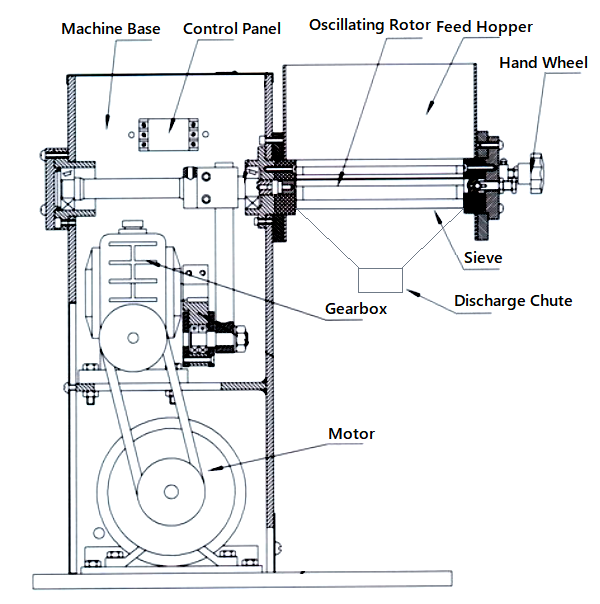Your cart is currently empty!
Oscillating Granulator
Oscillating Granulator
High Speed Uniform Granulation Process
Application & Process :
Oscillating granulator is used for gentle homogenization, size reduction, grading and sieving of dry, sensitive powders and granules in pharmaceutical, chemical and food industries.
Oscillating Granulator has one rotor with five edges, which oscillate on horizontal axis at about 180 per minutes. There is one half round sieve mounted at the bottom of the rotor. Product is charged from the top through in feed hopper and material falls on the rotor lades. The particles are broken by a set of oscillating bars arranged in cylindrical form over a screen of suitable mesh. Due to the sharp edges on rotor, the downsizing of particle takes place and through sieve material gets pushed outward from the bottom opening.
Salient Features :
- Design is cGMP – Current Good Manufacturing Practices compliance
- All Product contact parts AISI 316 & non contact parts AISI 304.
- Uniformly granulation & fewer fines of wet material and dry materials.
- Rotor move oscillating motion with 180 stroke per minute.
- Easy to operate; move, clean, convenient
- An Inline granulation & user friendly.
- Zero dusting & maintenance free.
Optional Features :
- Flame proof motor and Push Button Station.
- Inline granulation with Roll compactor & Tipper with FBD Bowl.
Safety Features :
- Limit switch at charging hopper & over load relay protection.
Oscillating Granulator Working Principle
How does an oscillating granulator work? It is quite simple to understand. Let’s take a closer look at the oscillating granulator working principle.

Materials to be granulated and binders (if required) are loaded into the feed hopper at the top of the granulator machine.
These substances fall onto the oscillating rotor—the rotor rotation alternates between clockwise and counterclockwise.
The rotor arms with sharp edges work to crush the large agglomerates into smaller particles in an oscillating and rotating manner.
The crushed particles are then forced through the oscillating granulator sieve to form the desired, uniform granule sizes.
During the granulation process, the rotor’s rotational speed and rotation time can be adjusted. Sieve hole sizes, as well as rotational speed and rotation angle of the rotor, are all the primary factors that influence particle size.
Oscillating Granulator Parts
What are the major parts that play a key role in the oscillating granulator working principle? Here’s a diagram of the granulator machine.

1. Feed Hopper
The feed hopper is used to load the materials to be granulated. Since the oscillating granulator can be used for wet granulation, the hopper is designed to hold pre-wetting materials. So, this component is typically constructed from stainless steel to prevent corrosion.

2. Oscillating Rotor
The oscillating rotor comes in a stainless-steel construction. It is mounted at the bottom of the feed hopper. This component features multiple arms that are arranged in a cylindrical fashion. These rotor arms with sharp edges function as blades to break down the large agglomerates.
The rotor works by oscillating and rotating on a horizontal axis. It rotates from side to side to crush the oversized product to be granulated. Both the rotational speed and time of the oscillating rotor are adjustable depending on the properties of raw materials.
3. Sieve
The sieve comes in a perforated metal sheet. It functions as a mesh screen and half wraps around the oscillating rotor from the bottom. With a stainless-steel construction, the sieve works to grade and screen the particles crushed by the oscillating rotor.

The oscillating granulator sieve is available in various sizes and perforated types. The screening is a key step in the oscillating granulator working principle. It helps achieve the desired particle sizes depending on your production needs.
4. Hand Wheels
The oscillating granulator generally has a pair of hand wheels. They come with removable bars to secure the sieve and adjust its tension. When the mesh screen needs to be replaced, you can unscrew the retaining nuts to pull out the adjustment bars without tools.
5. Discharge chute
The discharge chute is crafted from fully welded, mirror-polished stainless steel. The construction allows the granular materials to leave the device smoothly and completely.

6. Control Panel
Since the oscillating granulator is an easy-to-operate device, its control panel doesn’t come in a complex design. Typically, the control panel is composed of a START button, a STOP button, an EMERGENCY STOP button, and power indicators.

7. Motor and Gearbox
The electric motor and gearbox are enclosed in the machine base. The rotor is driven by the motor and gearbox to deliver oscillating and rotating motions for the granulation process.


